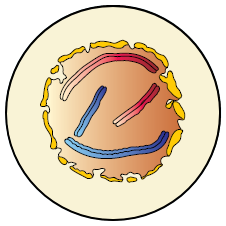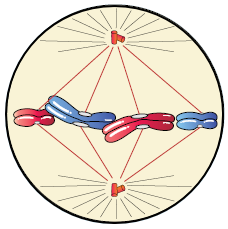Which of the following cells is in transition to metaphase?
1

2.

3.

4.






To unlock all the explanations of 38 chapters you need to be enrolled in MasterClass Course.

To unlock all the explanations of 38 chapters you need to be enrolled in MasterClass Course.
The Mitotic phase of a typical eukaryotic cell is divided into:
| 1. | Two stages | 2. | Three stages |
| 3. | Four stages | 4. | Five stages |

To unlock all the explanations of 38 chapters you need to be enrolled in MasterClass Course.

To unlock all the explanations of 38 chapters you need to be enrolled in MasterClass Course.
During which stage of mitosis do the following events occur?
| I: | Centromeres split and chromatids separate |
| II: | Chromatids move to opposite poles |
| 1. | Prophase | 2. | Metaphase |
| 3. | Anaphase | 4. | Telophase |

To unlock all the explanations of 38 chapters you need to be enrolled in MasterClass Course.

To unlock all the explanations of 38 chapters you need to be enrolled in MasterClass Course.
Which of the following is not a continuous process during cell cycle?
| 1. | Synthesis of DNA |
| 2. | Cell growth |
| 3. | Metabolism |
| 4. | Both cell growth and metabolism |
The enzyme recombinase functions during:
| 1. | Zygotene | 2. | Pachytene |
| 3. | Diplotene | 4. | Diakinesis |

To unlock all the explanations of 38 chapters you need to be enrolled in MasterClass Course.

To unlock all the explanations of 38 chapters you need to be enrolled in MasterClass Course.
Match each item in Column I with one in Column II and select the correct answer from the codes given below:
|
Column I |
|
Column II |
|
|
A |
Zygotene |
a |
Pairing of homologous chromosomes |
|
B |
Pachytene |
b |
Appearance of chiasma |
|
C |
Diplotene |
c |
Terminalization of chiasma |
|
D |
Diakinesis |
d |
Crossing over |
Codes:
| A | B | C | D | |
| 1. | a | c | b | d |
| 2. | a | d | b | c |
| 3. | a | b | c | d |
| 4. | b | c | d | a |

To unlock all the explanations of 38 chapters you need to be enrolled in MasterClass Course.

To unlock all the explanations of 38 chapters you need to be enrolled in MasterClass Course.
The cell shown in the given diagram is in:
 |
|

To unlock all the explanations of 38 chapters you need to be enrolled in MasterClass Course.

To unlock all the explanations of 38 chapters you need to be enrolled in MasterClass Course.
Identify the incorrect statement:
| 1. | The nuclear membrane and nucleolus reappear during Telophase I |
| 2. | The nuclear membrane disappears by the end of Prophase II |
| 3. | DNA replicates during interkinesis between meiosis I and meiosis II |
| 4. | Chromosomes do not reach the extremely extended state of interphase nucleus |

To unlock all the explanations of 38 chapters you need to be enrolled in MasterClass Course.

To unlock all the explanations of 38 chapters you need to be enrolled in MasterClass Course.
All the following are significances of mitosis except:
| 1. | Restoration of nuclear/cytoplasmic ratio |
| 2. | Growth of living organisms |
| 3. | Replacement of lost cells |
| 4. | Generation of genetic variation |

To unlock all the explanations of 38 chapters you need to be enrolled in MasterClass Course.

To unlock all the explanations of 38 chapters you need to be enrolled in MasterClass Course.
The key features of meiosis include all the following except:
| 1. | Pairing of heterologous chromosomes |
| 2. | Crossing over between non sister chromatids of homologous chromosomes |
| 3. | Four haploid cells produced at the end of the second division |
| 4. | Initiated after DNA replication in S phase |

To unlock all the explanations of 38 chapters you need to be enrolled in MasterClass Course.

To unlock all the explanations of 38 chapters you need to be enrolled in MasterClass Course.






